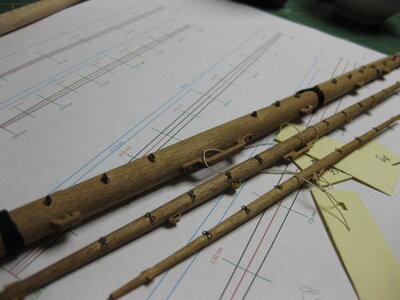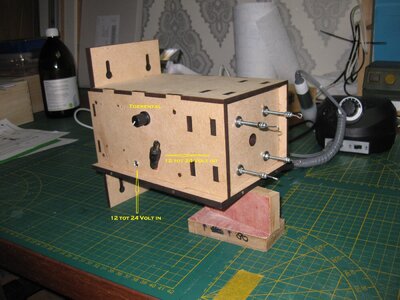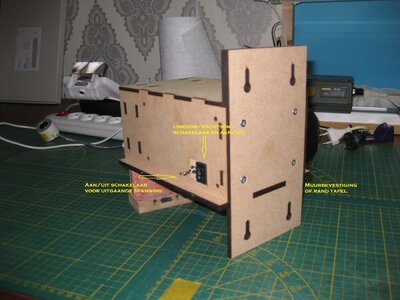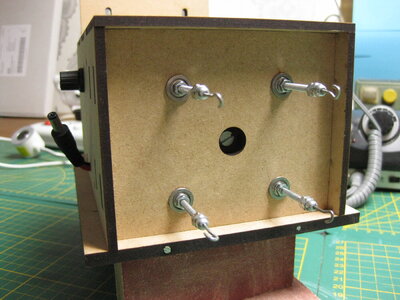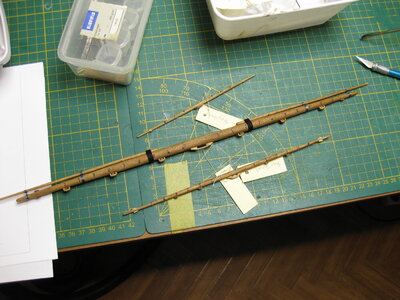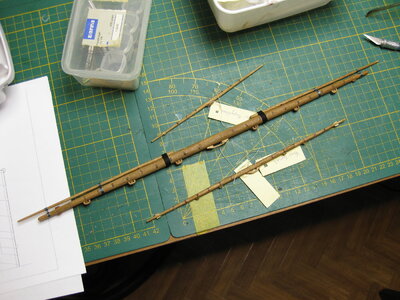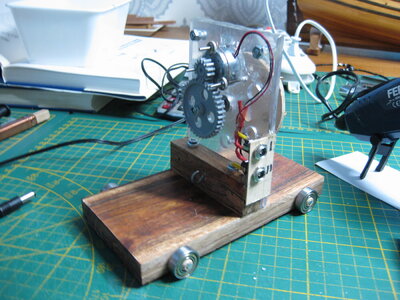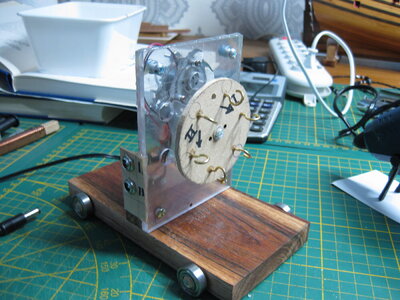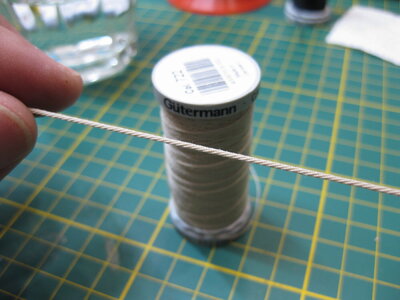-

Win a Free Custom Engraved Brass Coin!!!
As a way to introduce our brass coins to the community, we will raffle off a free coin during the month of August. Follow link ABOVE for instructions for entering.
-

PRE-ORDER SHIPS IN SCALE TODAY!
The beloved Ships in Scale Magazine is back and charting a new course for 2026!
Discover new skills, new techniques, and new inspirations in every issue.
NOTE THAT OUR FIRST ISSUE WILL BE JAN/FEB 2026
You are using an out of date browser. It may not display this or other websites correctly.
You should upgrade or use an alternative browser.
You should upgrade or use an alternative browser.
VOC ship The Prins Willem (scale 1:75) Year 1651
- Thread starter Steef66
- Start date
- Watchers 76
-
- Tags
- 1:75 prins willem
- Joined
- Aug 8, 2019
- Messages
- 5,546
- Points
- 738

Looks nice!
Ah...same I wanted to say, better to black them before fitting at place...
All the best!
Ah...same I wanted to say, better to black them before fitting at place...
All the best!
- Joined
- Aug 8, 2019
- Messages
- 5,546
- Points
- 738

A story to read about the flood

 cnnphilippines.com
cnnphilippines.com

Deadly floods inundated parts of Europe, but the Netherlands avoided fatalities. Here's why
As communities devastated by the catastrophic flooding in parts of western Europe start picking up the pieces, they are wondering how it all went so wrong, so fast. After all, Europe has a world-leading warning system that issued regular alerts for days before floods engulfed entire villages.
The Netherlands (and the coast regions of Germany) of course are specialized in avoiding damage caused by floods because they have learned from the experience in the past. But nobody could imagine, that rainfalls in the western regions of Germany (Rhineland-Palatinate) ever could cause floods on such a scale. I live in the southwest of Germany and for the first time saw the river in our village coming out and flooding the main street. Luckily there was only little damage because the flood was by far not as serious than in the regions of western Germany.A story to read about the flood

Deadly floods inundated parts of Europe, but the Netherlands avoided fatalities. Here's why
As communities devastated by the catastrophic flooding in parts of western Europe start picking up the pieces, they are wondering how it all went so wrong, so fast. After all, Europe has a world-leading warning system that issued regular alerts for days before floods engulfed entire villages.cnnphilippines.com
Terrible news, what happened in western Germany!
There is looks like global climate disaster slowly growing up... ((
((
There is looks like global climate disaster slowly growing up...
Good day Steef66,
Your rope machine looks cool!
Serious aparatus !!! ))
))
Regarding yards...
I have big doubts that there could be so many aux sheaves on them... probably a couple on the main yards but not on every yards...I think it is not ness- ry to mechanicaly duplicate them on each yard...?
Lead blocks for the aux sails ropes mostly placed on the stays loops or on the top platforms as I know...
Maybe You have some evidance of such arrangement which You reproduced on your model?
All the Best!
Ps
On this picture clear could be seen only two fixed sheaves on the main yard ... all othe leads blocks seazed to it or secured on the stay...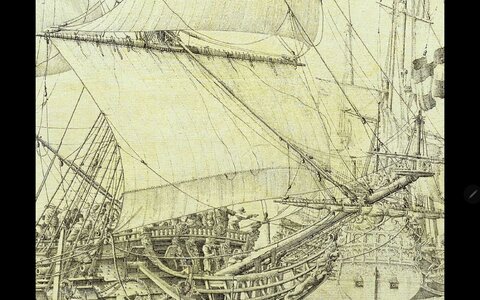
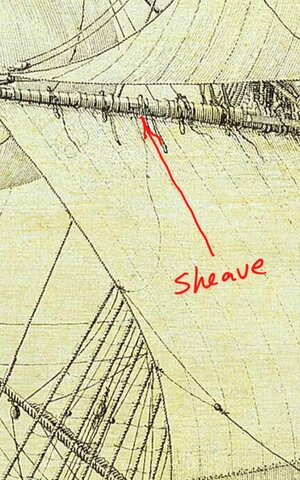
Your rope machine looks cool!
Serious aparatus !!!
Regarding yards...
I have big doubts that there could be so many aux sheaves on them... probably a couple on the main yards but not on every yards...I think it is not ness- ry to mechanicaly duplicate them on each yard...?
Lead blocks for the aux sails ropes mostly placed on the stays loops or on the top platforms as I know...
Maybe You have some evidance of such arrangement which You reproduced on your model?
All the Best!
Ps
On this picture clear could be seen only two fixed sheaves on the main yard ... all othe leads blocks seazed to it or secured on the stay...


Last edited:
Nice rope walk. You should consider to install a counter, to know how many turns you have to do to to twist the yarns.
- Joined
- Aug 8, 2019
- Messages
- 5,546
- Points
- 738

Thanks Kirill, yes it looks like there to many. But this was a big ship with big sails. For that time there where on the main and fore course each sail 4 buntlines and 2 leechlines. That are 6 sheaves each yard.I have big doubts that there could be so many aux sheaves on them...
On the topsails there are 2 buntlines an 2 leechlines. That are 4 sheaves. There is just a little difference in the fore mast and the main mast. Even the sails are almost the same in measurement.
Thanks Ab. Good idea. I will think about it. So I can make always the same looking rope. The rope walk is made in 2 parts. On the picture before is the main part. The other part is the moving car to twist the yarns. I will attach a picture below. The motor is very strong, not fast.Nice rope walk. You should consider to install a counter, to know how many turns you have to do to to twist the yarns.
I designed the machine in AutoCad, and let the MDF lasercut. Maybe Hans of Kolderstok will sell the machine. I give him all the plans of it.
Good day Steef66
Regarding blocks and sheaves, only leechlines passing trough sheaves of permanent blocks attached to the main yards, fore and main .
There are two sheaves for leechlines on each yards,on main sails only, no other blocks in such shape should be here.
Top sails,top gallant have no such shaped blocks on the yards at all.
Blocks for buntlines are not on the yard , but on the stays loop, if we are talking of Dutch rigging tradition of 17th century.
there are excelent drwngs as reference of dutch rigging style in Ab Hoving famous books ...
Ship on the picture I used as example not less in size that PW but there are only two such blocks visiable on the main yards.
Regarding blocks and sheaves, only leechlines passing trough sheaves of permanent blocks attached to the main yards, fore and main .
There are two sheaves for leechlines on each yards,on main sails only, no other blocks in such shape should be here.
Top sails,top gallant have no such shaped blocks on the yards at all.
Blocks for buntlines are not on the yard , but on the stays loop, if we are talking of Dutch rigging tradition of 17th century.
there are excelent drwngs as reference of dutch rigging style in Ab Hoving famous books ...
Ship on the picture I used as example not less in size that PW but there are only two such blocks visiable on the main yards.
Attachments
- Joined
- Feb 22, 2021
- Messages
- 130
- Points
- 253

Hi Stephan,
I've just noticed your discussion regarding leech line sheaves.
Krill is right. You have too many of them.
Sheaves should by only on main and fore yard. One on each side.
Quite common solution from that time.
Other leech lines should go through blocks hanged on the shroud eye... as Krill mentioned or like on Batavia (similar to later British example) through blocks hanged on the yard, however this seems to be only on the fore and main yard... top yards leech lines still should go through blocks hanged on the shroud eye.
Also... Willem Rex model has: 2 sheaves each for fore and main yard... then blocks hanged on the yard for other leech lines... but then rope is going to the top... so I guess it should have another blocks hanging to run the rope down to the belaying pin.
You have few options to choose
Have a look at the photo of Batavia plans from Leylstad Warf. (quick and ugly photo from the phone... sorry)
For this period just 2 for yard and only fore and main...
and only fore and main...
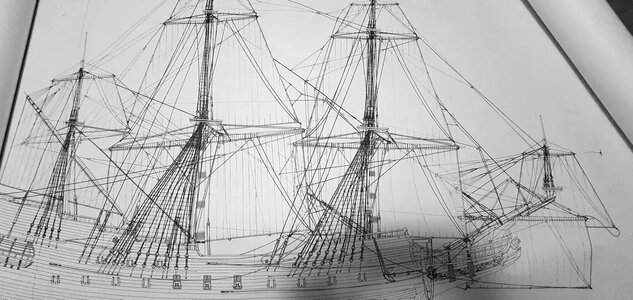
However, in later period we can already noticed... (for example on British) ships that you have already regular blocks for leech lines on each yard
Example from Petersson.
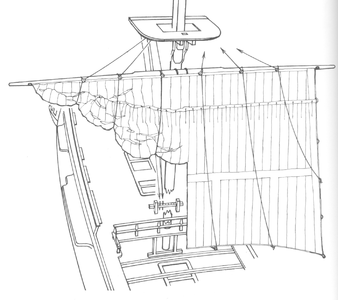
Nice new toy
Interesting idea to count turns.... However, I've never count turns on my ropewalk... instead... more or less I was keeping in mind distance of the moving ropewalk "cart" on the track to have nice and consistent looking ropes.
My motors have more than 1000rpm hard time to count even
hard time to count even 
Only for really thick ropes I'm dropping rpm's down... otherwise everything up to ~1,2mm is going on full speed to not waste time... especially on the thinest.
Cheers,
Matt
I've just noticed your discussion regarding leech line sheaves.
Krill is right. You have too many of them.
Sheaves should by only on main and fore yard. One on each side.
Quite common solution from that time.
Other leech lines should go through blocks hanged on the shroud eye... as Krill mentioned or like on Batavia (similar to later British example) through blocks hanged on the yard, however this seems to be only on the fore and main yard... top yards leech lines still should go through blocks hanged on the shroud eye.
Also... Willem Rex model has: 2 sheaves each for fore and main yard... then blocks hanged on the yard for other leech lines... but then rope is going to the top... so I guess it should have another blocks hanging to run the rope down to the belaying pin.
You have few options to choose
Have a look at the photo of Batavia plans from Leylstad Warf. (quick and ugly photo from the phone... sorry)
For this period just 2 for yard

However, in later period we can already noticed... (for example on British) ships that you have already regular blocks for leech lines on each yard
Example from Petersson.

Nice new toy
Interesting idea to count turns.... However, I've never count turns on my ropewalk... instead... more or less I was keeping in mind distance of the moving ropewalk "cart" on the track to have nice and consistent looking ropes.
My motors have more than 1000rpm
Only for really thick ropes I'm dropping rpm's down... otherwise everything up to ~1,2mm is going on full speed to not waste time... especially on the thinest.
Cheers,
Matt
Last edited:
- Joined
- Aug 8, 2019
- Messages
- 5,546
- Points
- 738

Krill and Matt thanks. Your right about the courses. There is just indeed only 2 sheaves for the lower leechlines. The buntlines must have blocks. Why i make this decision I don"t know. Think I read to much. 

I can change that very Quick. Thanks for the correction.
On the topsails I attached them the same way. But if there where also sheaves on the lower leechlines, I'm not sure. In Anderson there is a drawing that they crossed the buntlines. And it looks they went trough sheaves. He says also there is nothing clear about the buntlines and how they lead.
I change them to blocks. Seems to be the most correct way.

I can change that very Quick. Thanks for the correction.
On the topsails I attached them the same way. But if there where also sheaves on the lower leechlines, I'm not sure. In Anderson there is a drawing that they crossed the buntlines. And it looks they went trough sheaves. He says also there is nothing clear about the buntlines and how they lead.
I change them to blocks. Seems to be the most correct way.
Good day Stephan,
I left early attached pdf file of highest resolution of pinass rigging and pdf file with rigging description...all made by top authority for this subject -Mr. Ab Hoving.
If You spent some time to study them( + Anderson under hand))), I think all questions about Dutch rigging of 17th century became cristal clear...at least more than for rigging your model ))
))
All the best!
K i r i l l
I left early attached pdf file of highest resolution of pinass rigging and pdf file with rigging description...all made by top authority for this subject -Mr. Ab Hoving.
If You spent some time to study them( + Anderson under hand))), I think all questions about Dutch rigging of 17th century became cristal clear...at least more than for rigging your model
All the best!
K i r i l l
- Joined
- Feb 22, 2021
- Messages
- 130
- Points
- 253

Hi Stephan,
I was looking at some other plans comparing Batavia, Willem Rex, De 7 Provinciën and Prins Willem...
...and in term of leech lines and buntlines looks like you should have only 2 on each side and for each sail with some exception mentioned below.
I think good way to run them will be only through blocks on shroud eye without blocks on the yard (this solution seems to be on heavier vessels... like Willem Rex for example or De 7 Provinciën)
Example... beautiful model of Vitaly Anahin
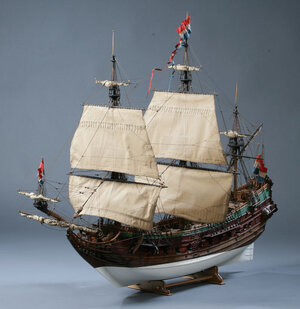
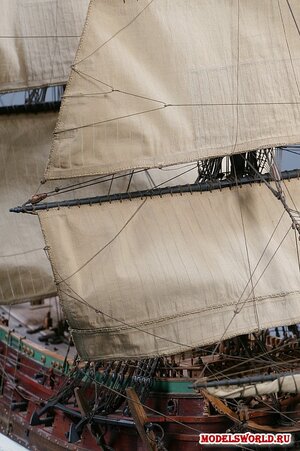
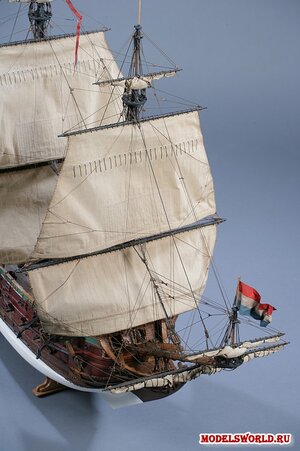
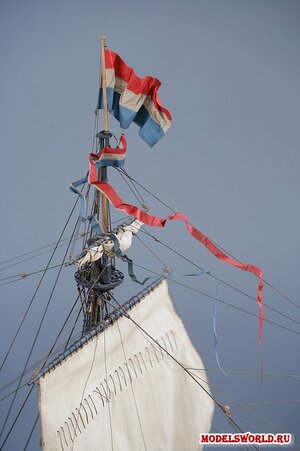
Topgallant sails, spritsail topsail and mizen topsail does not have leech lines... at least I didn't see them on my examples (except Willem Rex... where you can see clearly one central leech line)
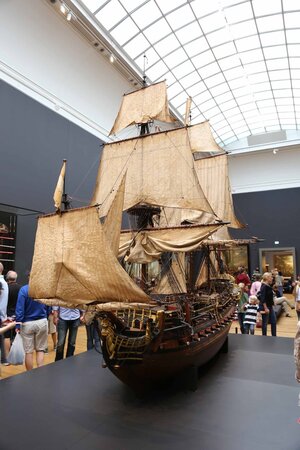
So I think the best way will be to replicate leech lines like Ab present on his Pinas Witsen plans, which Kirill also mentioned.
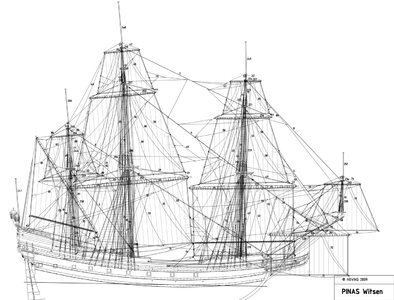
Cheers,
Matt
I was looking at some other plans comparing Batavia, Willem Rex, De 7 Provinciën and Prins Willem...
...and in term of leech lines and buntlines looks like you should have only 2 on each side and for each sail with some exception mentioned below.
I think good way to run them will be only through blocks on shroud eye without blocks on the yard (this solution seems to be on heavier vessels... like Willem Rex for example or De 7 Provinciën)
Example... beautiful model of Vitaly Anahin




Topgallant sails, spritsail topsail and mizen topsail does not have leech lines... at least I didn't see them on my examples (except Willem Rex... where you can see clearly one central leech line)

So I think the best way will be to replicate leech lines like Ab present on his Pinas Witsen plans, which Kirill also mentioned.

Cheers,
Matt
Last edited:
- Joined
- Aug 8, 2019
- Messages
- 5,546
- Points
- 738

Yes I looked at all these plans and study a lot of books. I think that I made the mistake by taking up to to much info. Can't find anywhere back why I give the buntlines sheaves and do the same on the topsails with bunt and leech lines. When Kirill mentioned it the first time I got already a doubt about it that it could be wrong what I was doing. So in the pictures below you can see the result of my research. And in red the new situation to replace the sheaves by blocks. The courses have 4 buntlines and then topsails got 2 buntlines. Every thing with blocks and only the leech lines (lower) of the courses with sheaves. The exact place where sheaves and blocks where attached to the yard come from the book of James Lees. The way the buntlines on the William Rex are mounted is for the PW not correct. The William Rex got his rigging period late 17th century. The PW mid 17th century. There are a lot of changes in rigging in these short time of years. That's why it is so difficult. A lot drawings what we have of old ships of that time period don't even show buntlines. Because they where nearly visible to see on the ships. That's why Anderson don't give a good a good plan how these lines where mounted.
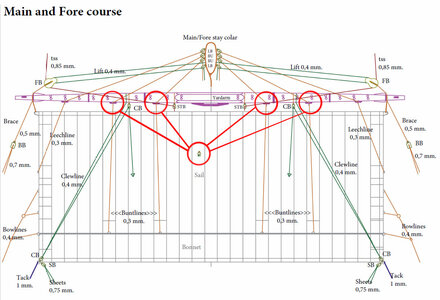
leech line of the topsail wil not have a block on the yard
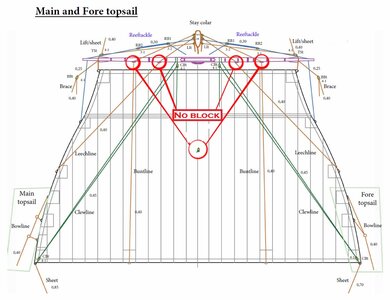

leech line of the topsail wil not have a block on the yard

- Joined
- Feb 22, 2021
- Messages
- 130
- Points
- 253

It's another interesting mistery 
Ok... but from which source you've got conclusion that you should have 4 buntlines on main and fore course?
From what I've seen on plans, photos of different models it was always just 2 buntlines for fore, main and topsails.
Probably if I were you I would have same mix in the head how to do them
The other mistery are blocks on the yards for buntlines... kind of typical for Dutch... but I haven't seen them on the PW models...
However, on Batavia rigging plans they are included... same as 4 buntlines...
Nagelboom (also around 1650 and I think close enough to PW) model shown at Rede van Texel diorama has 2 buntlines for main, fore and tops.
One more question... on your main/fore course drawing you have buntlines fixed to cringles to the sail but not to the bonnet...? Are you sure about it? Haven't seen this... (except one or two paintings)
In my opinion cringles should be on the bonnet and buntlines should extend and end up over there.
...and I guess bonnet applies only to the fore course? Haven't seen bonnet on main course often... are you sure PW should have one on main?
Funny, but PW from Rijksmuseum doesn't have bonnet
Some photos for more confusions
Just curious what @Ab Hoving thinks about it
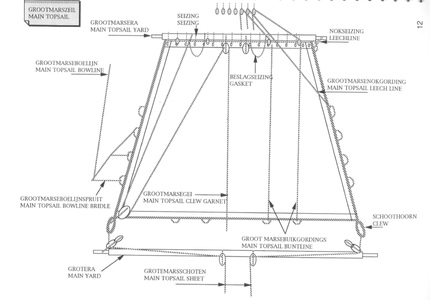
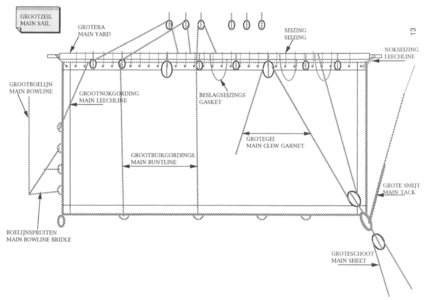
Nagelboom
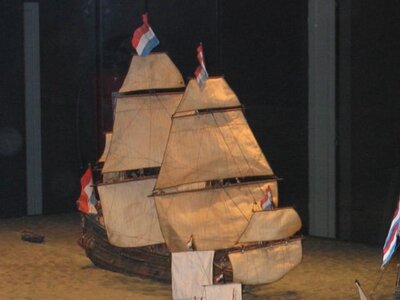
Cheers,
Matt
Ok... but from which source you've got conclusion that you should have 4 buntlines on main and fore course?
From what I've seen on plans, photos of different models it was always just 2 buntlines for fore, main and topsails.
Probably if I were you I would have same mix in the head how to do them

The other mistery are blocks on the yards for buntlines... kind of typical for Dutch... but I haven't seen them on the PW models...
However, on Batavia rigging plans they are included... same as 4 buntlines...
Nagelboom (also around 1650 and I think close enough to PW) model shown at Rede van Texel diorama has 2 buntlines for main, fore and tops.
One more question... on your main/fore course drawing you have buntlines fixed to cringles to the sail but not to the bonnet...? Are you sure about it? Haven't seen this... (except one or two paintings)
In my opinion cringles should be on the bonnet and buntlines should extend and end up over there.
...and I guess bonnet applies only to the fore course? Haven't seen bonnet on main course often... are you sure PW should have one on main?
Funny, but PW from Rijksmuseum doesn't have bonnet

Some photos for more confusions

Just curious what @Ab Hoving thinks about it


Nagelboom

Cheers,
Matt
Last edited:
- Joined
- Aug 8, 2019
- Messages
- 5,546
- Points
- 738

@mati.n
I did find it in James Lees - The Masting and Rigging of English Ships of War 1625-1860 page 134 there are the sails of English and continental ships.
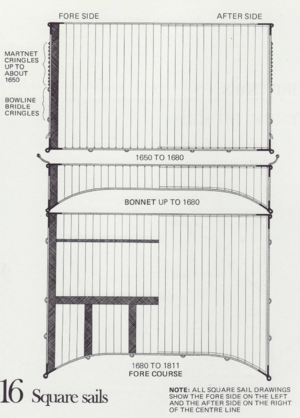
Buntline cloths The courses generally had four buntline cloths, each one breadth of cloth, running from the foot of the sail to the middle band; the middle band was sewn over the ends of the bunt cloths. The cloths were spaced equally along the foot Up to about 1811, the cloths ran vertically up the sail, and after 1811, only the inner cloths were vertical- the outer cloths sloped inwards by one cloth of the sail at the middle band The topsail had two buntline cloths, each a cloth wide, sewn on one third of the foot from each leech like those on the courses sewn under the middle band; the topsail bunt cloths were vertical at all periods. All bunt cloths were sewn over the foot linings. I have seen no evidence of buntline cloths in use prior to the introduction of the middle band; probably they were not
found necessary when the sails were relatively small Topgallant and royal sails were not fitted with buntline cloths. James Lees - The Masting and Rigging of English Ships of War 1625-1860
the drawing below are the drawings from the rigging plan the Rijksmuseum in Amsterdam have of the PW
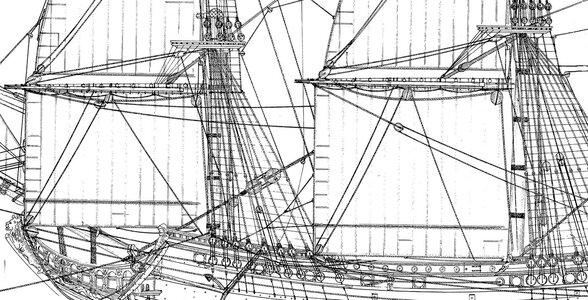
you can see that there are 2 pairs of buntline installed on the courses (the sqaures in the sails on the bottom.
These sails have the buntlines on the bonnet, different to the book of James Lees
It is difficult to explain what is correct, but when I combine the drawings of the museum and James Lees and Anderson I think 4 buntlines are correct. And if the cringles are attached to the bonnet or to the sail is hard to say. In the drawing of the museum they're attached to the bonnet in Lees to the sail. But logical thinking, when the bonnet is take of, where would the buntlines attached
I can email page 134 to 142 if you interrested to read. Send me your email in PM, I wil send the drawings of the museum to.
I did find it in James Lees - The Masting and Rigging of English Ships of War 1625-1860 page 134 there are the sails of English and continental ships.

Buntline cloths The courses generally had four buntline cloths, each one breadth of cloth, running from the foot of the sail to the middle band; the middle band was sewn over the ends of the bunt cloths. The cloths were spaced equally along the foot Up to about 1811, the cloths ran vertically up the sail, and after 1811, only the inner cloths were vertical- the outer cloths sloped inwards by one cloth of the sail at the middle band The topsail had two buntline cloths, each a cloth wide, sewn on one third of the foot from each leech like those on the courses sewn under the middle band; the topsail bunt cloths were vertical at all periods. All bunt cloths were sewn over the foot linings. I have seen no evidence of buntline cloths in use prior to the introduction of the middle band; probably they were not
found necessary when the sails were relatively small Topgallant and royal sails were not fitted with buntline cloths. James Lees - The Masting and Rigging of English Ships of War 1625-1860
the drawing below are the drawings from the rigging plan the Rijksmuseum in Amsterdam have of the PW

you can see that there are 2 pairs of buntline installed on the courses (the sqaures in the sails on the bottom.
These sails have the buntlines on the bonnet, different to the book of James Lees
It is difficult to explain what is correct, but when I combine the drawings of the museum and James Lees and Anderson I think 4 buntlines are correct. And if the cringles are attached to the bonnet or to the sail is hard to say. In the drawing of the museum they're attached to the bonnet in Lees to the sail. But logical thinking, when the bonnet is take of, where would the buntlines attached
I can email page 134 to 142 if you interrested to read. Send me your email in PM, I wil send the drawings of the museum to.

